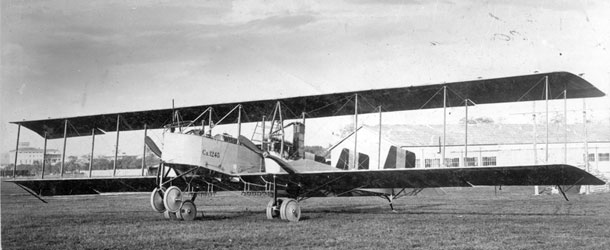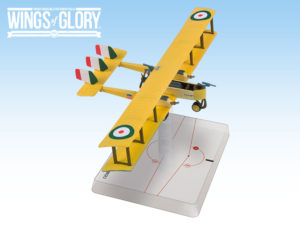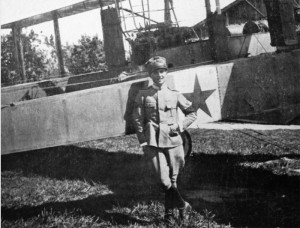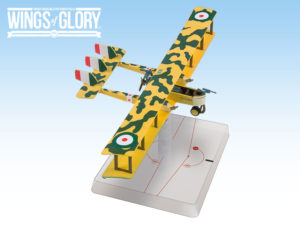The WW1 bombers are coming back in Wings of Glory. The first WW1 Special Packs featuring the Gotha G.V and the Caproni Ca.3 are presently sold out, but these aircraft will be available again soon – they are expected to release in May. The Gotha G.V Aschoff and Von Korff will be reproduced, and the Caproni Ca.3 will be presented in two new versions, depicting the aircraft used by Captain Guido Taramelli and the duo Federico Zapelloni and Fiorello La Guardia (who was also a congressman at the time and later New York mayor).
Information about the aircraft and pilots of the two Gotha G.Vs were previously released and can be seen here. The Caproni Ca.3 and the two models released in 2012 are also presented in a previous article. As the bomber history and characteristics are already available in that article, it’s time to learn something about the two new miniatures arriving in this second release.
Fiorello La Guardia and Federico Zapelloni
The Caproni Ca.3 piloted by Captain Federico Zapelloni together with U.S. Major Fiorello La Guardia has the U.S. ensigns on the fuselage. It was one of the bombers used by the American Army Air Service in the World War I.
Born in 1882 in Greenwich Village, in Manhattan, Fiorello La Guardia was the son of a recent immigrant from Foggia, Italy. From 1901 to 1906, La Guardia served in the American Consular Service in Hungary and Trieste, Austria, before returning to the US to work as an interpreter at Ellis Island. He graduated as a lawyer in 1910, and in 1915 he became deputy attorney general for the state, assigned to the New York City bureau. In March 1917, he was elected as a Republican to the Sixty-fifth and Sixty-sixth Congresses.

La Guardia in front of Caproni "The Congressional Limited" with Cambiaso Negrotto, Federico Zapelloni and Sgt.Firmani (seated).
When the US entered the war, La Guardia insisted on going to the front. He was too short to be a soldier, but had learned to fly before the war, so he signed up for the US Air Service. He absented himself from the House and on August 15, 1917, was commissioned a first lieutenant in the Army Air Service. Promoted to the rank of captain and later to major, he commanded the United States air forces on the Italian-Austrian front.
In Fall 1917, he led a contingent of American flying cadets to Foggia, Italy, for training. Between September 28, 1917, and June 25, 1918, a total of 406 US pilots graduated at Foggia. They were known as “the Foggiani,” or “Fiorello’s Foggiani” in honor of their flamboyant leader and champion. Caproni pilots could go on to complete the bombardment course at Foggia, and 131 of the Foggiani did so. La Guardia began his own training in the Caproni in October 1917, but did not finish until the middle of March 1918, because so much of his time was taken by administrative duties.
Most American pilots trained in Italy were sent to France for service with the AEF, but a detachment of about 75 remained under command of La Guardia and flew missions with the Italian air force. The first American bomber pilots left Foggia for the front on June 15. They were attached to Italian bomber squadrons at Padua, Verona, and Aquila to gain experience and augment under strength units. After flying four or five missions with experienced Italian pilots, they were given command of a CA-450 or CA-600 with an Italian combat crew.
La Guardia was promoted to major on August 8th, and managed to fly five combat missions in the Caproni in September. His total combat time logged was 10 hours and 20 minutes. In his missions, he flew with the Italian pilots Federico Zapelloni and Cambiaso Negrotto, who was also a parliamentary minister, using the aircraft presented in the WW1 Wings of Glory Airplane Pack. He nicknamed his bomber “The Congressional Limited”.
He returned to the US on October 1918, and was re-elected in November. He resigned his commission, went back to Congress, and served until 1932. In January 1934, he was elected mayor of New York for the first time and began his long and successful run at City Hall. Fiorello H. La Guardia was the first man in modern times to be elected Mayor of New York for three consecutive terms.
La Guardia's role in Italy during WW1 was not confined to bomber missions, however, or administrative duties. At a moment Italy was facing a string of military reversals, he was chosen to deliver a series of pep talks to Italian civilians and armed forces, telling them American soldiers were on the way to help. With his diplomatic skills, his ties to Italy, and his status as a member of Congress, he was very successful. He was made a “commendatore” by the Italian Government for his services as a spellbinder, and awarded the Italian War Cross for his war service bombing the Austrian lines.
Federico Zapelloni is not quite as famous as his American mate, but he was one Italy's best pilots and an “ace” in bombing missions. Born in Rome, in 1891, Zapelloni was also an aeronautical engineer and pioneer. In 1911, he flew a monoplane glider he designed and built by himself. Already an official of the Regio Esercito, he received his military pilot’s license in 1915, and in early 1917 he was sent to the front.
Assigned to the XII Bomber Squadron, he was soon promoted to Captain and given command of the unit, due to his ability to face the faster and nimbler fighters - even piloting the heavy and slow Caproni. He devised a daring maneuver: he allowed enemies to tail, and then he set up a quick climb followed by an engine stoppage, which resulted in altitude and speed losses. The fighters, unable to change route and slow down in time, were forced to overfly him and enter the range of his Caproni’s front machine gun. Under his command, XII Bomber Squadron was the only one to take part in all missions without a single staff loss. He also performed several night missions, destroying strategic Austrian bases.
In June 1917, leading a formation of three Caproni Ca.33, he strafed Nabresina and the Prosecco (Trieste) field, receiving the Silver Medal for Military Valour. In August, he collaborated with Gabriele D’Annunzio to plan and execute the bombing of Pola port and arsenal.
Zapelloni was a instructor in Foggia for some time and there he met La Guardia, who was training American cadets. They became friends and conducted many missions together. They continued to meet after the war, and in 1946, when La Guardia became director general of the United Nations Relief and Rehabilitation Administration, he called Zapelloni to collaborate with him.
After the end of WW1, Zapelloni remained in the military, being dismissed only after the WW2, with the grade of General. He died in 1979, in Rome. He was awarded the Golden Medal of Military Valour, five Silver medals, two bronze medals, and four War Crosses, among many other military and civilian distinctions.
Guido Taramelli
The other Caproni Ca.3 presented in Wings of Glory is the Ca.11505 from the 1a Squadriglia, based in S.Pelagio, Padova, and commanded by Captain Guido Taramelli in 1918. In addition to the camouflage, Caproni Ca.11505 has the unit badge (a red star on a white panel) on the tail booms and on the upper face, with the Latin motto “Audaces fortuna iuvat” (Luck is with those who dare) on the nose.
Born on October 21st, 1895, in Bergamo, Guido Taramelli joined the Regio Esercito just after Italy entered WW1, in Spring 1915. He was assigned to the 56a Fanteria as a second lieutenant. In June 1916, he got his transfer to the Italian Air Service, and within one year he was a captain with two silver medals, three War Crosses, and more than 70 missions performed.
The 1a Squadriglia was based in Comina Field until late October 1917, when it retired to S.Pelagio after the October 24th Battle of Caporetto (when Austrians and Germans launched the Waffentreu operation). A huge artillery barrage was followed by infantry using Hutier tactics, bypassing enemy strong points and attacking the Italian rear. At the end of the first day, the Italians had retreated 12 miles to the Tagliamento River. The squadron was hard pressed to slow imperial divisions chasing the retreating Italian troops.
Invited by Gabriele D’Annunzio, Taramelli joined the 87a Squadriglia, renamed Squadriglia San Marco, probably in the second half of 1918. In this unit, he met the pilots Antonio Locatelli, Natale Palli, and Gino Allegri. He died in June 1919, age 24, when he was ending a flight in Venezia skies. In honor of his friend and unit mate, Locatelli gave his name to the Aero Club di Bergamo, the city where they born, when it was created in 1930.
Information sources: United State Congress – Biographical Directory, New York Times, Air Force Magazine, HistoryNet.com, Wikipedia, "The First Air Campaign: August 1914- November 1918" (Eric Lawson & Jane Lawson), Frintinu Me, "Caproni Ca.3 – Windsock Datafile 78" (Gregory Alegi), "I Reparti dell'aviazione italiana nella Grande Guerra" (Roberto Gentilli, Paolo Varriale), "Capitano Pilota Guido Taramelli - L'Alalassio" (Paolo Sabatini).












